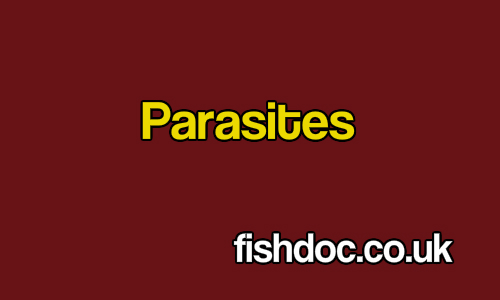Parasites pose a very real risk to to fish
All fish are potential hosts to many different species of parasites. Small numbers of parasites are common and probably do little harm. However, all parasites have tremendous reproductive potential and can, under ideal conditions, quickly overwhelm fish in the confines of a tank or pond.
Types of parasites
We can broadly class parasites into two groups. Ectoparasites are found on the external surfaces such as skin, fins and gills, while endoparasites are found in the internal tissues and organs.
Endoparasites are uncommon in ornamental fish. However, there is a wide diversity of blood parasites, worms that colonize the intestines and other parasites that can invade various organs and tissues. Many require an intermediate host, such as snails, birds or the introduction of an infected fish, and so are rare in pond/ aquarium fish. There are a variety of clinical signs which might indicate the presence of endoparasites. Lethargy accompanied by emaciation is a common sign, as are worms protruding from the anus. Identification of sporozoan and protozoan endoparasites often requires microscopic examination of tissues.
Ectoparasites are a common problem
For hobbyists, endoparasites are the most common parasite problem. With few exceptions, these parasites are not life-threatening in small numbers, indeed small populations are fairly normal. The danger from endoparasites comes from their tremendous reproductive potential. In a natural environment this rarely leads to severe outbreaks, as only small numbers of juveniles would survive and find a host after hatching. Limited physical contact between fish would prevent parasites being transferred to a new host, so limiting the spread of the infestation although individual fish may be severely parasitised.
The confines of a pond or tank, with fish constantly coming into contact with each other, provide ideal conditions for fish-to-fish parasite transfer. The ready-availability of fish hosts results in high survival rates of juveniles hatched from eggs and cysts deposited in the pond. This can lead to serious parasite outbreaks affecting many fish.
Fish can control numbers
The mucus layer, or cuticle, provides fish with some protection from parasites. In healthy fish it is continuously sloughed off, making it difficult for parasites to get a good foothold. Additionally, it contains various substances such as lysozyme, specific immunoglobins and free fatty acids, which are believed to have anti-pathogen properties. I stress that this assumes a healthy fish, living in a stress-free environment.
The situation changes when the fish are stressed, or the cuticle is being affected by adverse water quality such high ammonia/nitrite levels, inappropriate pH or other toxins. Under such conditions the consistency and protective properties of the cuticle can be severely altered, allowing parasites to proliferate.
Cuticle doesn’t protect against all parasites
Although the cuticle offers some protection against parasite infestation, there are several parasites that are not hindered by its presence. These are mainly the larger parasites such as Argulus (fish louse) and Lernaea (anchor worms), but a very important exception is Ichthyophthirius (white-spot).
Secondary infections
In large numbers ectoparasites can cause severe damage to the integument from their feeding activities and /or their constant movement and attachment structures such as hooks and suckers. This in turn can often lead to secondary bacterial infections, typically body ulcers and bacterial gill disease.
The irritation caused by ectoparasites often leads to excess mucus production, seen as a grey, slime film, and epithelial hyperplasia, causing respiratory problems if the gills are affected.
Signs of parasite infestation
The larger parasites such as leeches, lice and anchor worms are visible with the naked eye. Typical signs of parasite infestations are rubbing, ‘flashing’ [there is a flash of silver from the underside of the fish it turns its body to rub against something], focal redness and inflammation on the body – often at the base of the dorsal fin, flared operculum, respiratory difficulties, lethargy and bacterial ulcers. However, it is important to realise that these ‘symptoms’ are not exclusive to parasites and may be caused by poor water quality or other diseases.
Identification, diagnosis and treatment
Most ectoparasites are too small to be seen with the naked eye. It simply isn’t possible to be certain that parasites are present without taking a mucus and gill sample for microscopic examination.
This important procedure enables us to see which parasites are present on the skin and gills and determine the severity of the infestation. It is common to find more than one species present.
With this information we can implement an effective treatment plan that takes account of the life cycle of the parasite. This is particularly important with parasites such as white-spot, which have complex life cycles, including a period off the host. Failure to treat all stages will lead to re-infection.
Another consideration is that different parasites often need different treatments. This can be important when more than one species is involved. While general anti-parasite treatments are effective with most parasites, they do not treat all parasites. Sometimes, for various reasons such as under-dosing, water chemistry, organic pollution or green water, treatments do not work. This is why it is important to carry out a follow-up examination at the conclusion of the treatment, particularly when one of the real ‘nasties such as white-spot, Chilodonella or Costia are involved.

